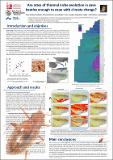Por favor, use este identificador para citar o enlazar a este item:
http://hdl.handle.net/10261/95500COMPARTIR / EXPORTAR:
 SHARE
BASE SHARE
BASE
|
|
| Visualizar otros formatos: MARC | Dublin Core | RDF | ORE | MODS | METS | DIDL | DATACITE | |

| Título: | Are rates of thermal niche evolution in cave beetles enough to cope with climate change? |
Autor: | Sánchez-Fernández, David CSIC ORCID; Cieslak, Alexandra CSIC ORCID; Faille, Arnaud CSIC ORCID; Fresneda, Javier; Rizzo, Valeria CSIC; Nieto-Lugilde, D.; Ribera, Ignacio CSIC ORCID | Fecha de publicación: | sep-2013 | Citación: | Adapting to Global Change in the Mediterranean hotspot (2013) | Resumen: | Climate change has become one of the main threats to global biodiversity. However, the extent to which species are threatened by climate change depends on how they respond to these new climatic conditions. They can disperse to more suitable locations, or they can cope through phenotypic plasticity and, ultimately, via evolutionary adaptation. Most of the studies of the evolutionary and biogeographical consequences of climatic change have been done with terrestrial, mainly vertebrate species. These models present some important uncertainties, as depending on the use of different microhabitats at different times within the same area the species can be exposed to a range of temperature or humidity sometimes much wider than the change predicted by the most pessimistic scenarios of climate change. The possibility of range movement tracking suitable habitats is also a confounding factor when trying to infer the conditions at which these species were subjected in the past. Here we present a system in which most of these uncertainties do not apply: the deep subterranean environment. The temperature of a cave is highly constant through the year and can be estimated from the mean annual temperature of the surface, and the humidity is always near to the saturation point. These conditions are homogeneous through all possible microhabitats within a cave system, and constant through the year. Most highly specialized cave species have also extremely narrow geographical ranges, which allows to trace their geographical movements through several cladogenetic processes. We focused on a well defined clade of troglobitic beetles of the tribe Leptodirini (Coleoptera, Leiodidae) living in the North-eastern Iberian Peninsula (from the Pyrenees to the coast of Catalonia), including ca. 140 taxa. Most of them are narrow endemic species with a well known distribution. We aim to estimate the rate of thermal niche evolution using two approaches: i) we first reconstructed a minimum rate of evolutionary change from a time calibrated phylogeny using only the current thermal niche of the species; and ii) we then introduced the constraint of the paleotemperatures of the areas occupied by these species during the Pleistocene glacial periods. We finally compare these rates with predicted rates of climate change from 2000 to 2100 for the same areas. | Descripción: | Póster presentada en la conferencia Adapting to Global Change in the Mediterranean hotspot (AGCM), celebrada en Sevilla del 18 al 20 de septiembre de 2013. | URI: | http://hdl.handle.net/10261/95500 |
| Aparece en las colecciones: | (IBE) Comunicaciones congresos |
Ficheros en este ítem:
| Fichero | Descripción | Tamaño | Formato | |
|---|---|---|---|---|
| poster_david_sanchez_2013.pdf | 1,94 MB | Adobe PDF |  Visualizar/Abrir |
CORE Recommender
Page view(s)
250
checked on 23-abr-2024
Download(s)
110
checked on 23-abr-2024
Google ScholarTM
Check
NOTA: Los ítems de Digital.CSIC están protegidos por copyright, con todos los derechos reservados, a menos que se indique lo contrario.
